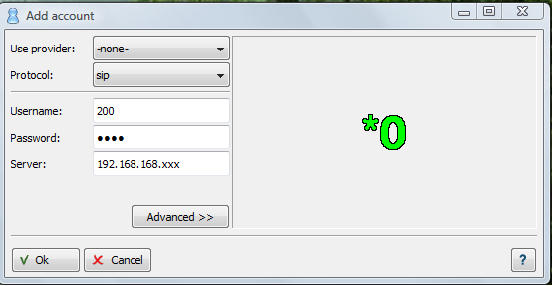Yate as SIP server
| Line 1: | Line 1: | ||
| + | ===Why this document=== | ||
| − | To check this functionality use: | + | Learn how to: |
| + | * modify Yate's configuration files in order to use it as SIP server; | ||
| + | * use YateClient as an SIP client; | ||
| + | * set up a telephony account on a SNOM 360 phone. | ||
| + | |||
| + | === Main concepts === | ||
| + | |||
| + | The important issue in this article is that Yate knows SIP protocol. | ||
| + | |||
| + | ===Test situation=== | ||
| + | |||
| + | To check this functionality ''Yate as a SIP server'' use: | ||
* a Yate installed on a server | * a Yate installed on a server | ||
| − | * a Yate | + | * a Yate Client installed on another server.See [http://yateclient.yate.ro/index.php/Download/Download Download] section. |
* a SNOM phone (you can follow the steps from this tutorial:[[Yate_as_H323_GateKeeper_and_YateClient_as_H323_client#Configuring_Snom_phone| to configure SNOM phone]]) | * a SNOM phone (you can follow the steps from this tutorial:[[Yate_as_H323_GateKeeper_and_YateClient_as_H323_client#Configuring_Snom_phone| to configure SNOM phone]]) | ||
| − | The purpose of this configuration schema is to make calls from SNOM phone to account in Yate client | + | The purpose of this configuration schema is to make calls from SNOM phone to account in Yate client using a SIP server or viceversa. |
| − | The | + | The easiest way to do it is to register this 2 accounts in regfile.conf and in ysipchan.conf you can use the general set up. The port options sets the port to which Yate will bind for SIP signalling. You may also specify an IP address (for multihomed machines) else Yate will listen on all interfaces. |
| − | + | ||
| − | + | So in configuration files set: | |
| − | [ | + | |
| − | + | regfile.conf | |
| + | [100] | ||
| + | password=mysecret1 | ||
| − | [ | + | [200] |
| − | + | password=mysecret2 | |
| − | + | ||
| − | + | Start Yate Server. | |
| + | |||
| + | Configure SNOM phone as it is done [[Yate_as_H323_GateKeeper_and_YateClient_as_H323_client#Configuring_Snom_phone| here]]. | ||
| + | |||
| + | Configure the other account in your Yate client like in image: | ||
| + | |||
| + | [[File:YC_sip_account.png]] | ||
| − | + | After all configuration it is done you can make calls. | |
Revision as of 15:49, 10 October 2012
Why this document
Learn how to:
- modify Yate's configuration files in order to use it as SIP server;
- use YateClient as an SIP client;
- set up a telephony account on a SNOM 360 phone.
Main concepts
The important issue in this article is that Yate knows SIP protocol.
Test situation
To check this functionality Yate as a SIP server use:
- a Yate installed on a server
- a Yate Client installed on another server.See Download section.
- a SNOM phone (you can follow the steps from this tutorial: to configure SNOM phone)
The purpose of this configuration schema is to make calls from SNOM phone to account in Yate client using a SIP server or viceversa.
The easiest way to do it is to register this 2 accounts in regfile.conf and in ysipchan.conf you can use the general set up. The port options sets the port to which Yate will bind for SIP signalling. You may also specify an IP address (for multihomed machines) else Yate will listen on all interfaces.
So in configuration files set:
regfile.conf
[100] password=mysecret1 [200] password=mysecret2
Start Yate Server.
Configure SNOM phone as it is done here.
Configure the other account in your Yate client like in image:
After all configuration it is done you can make calls.
